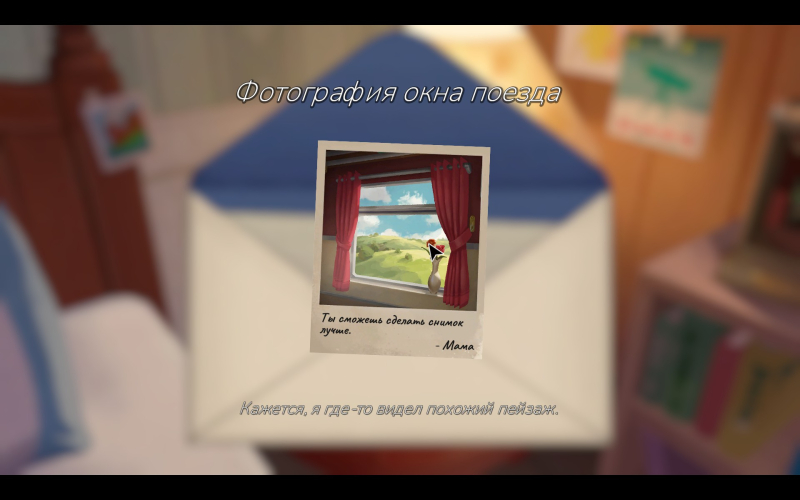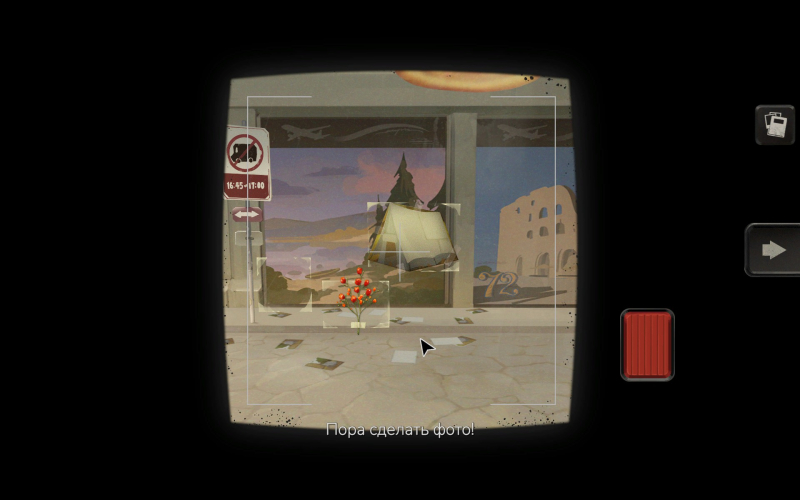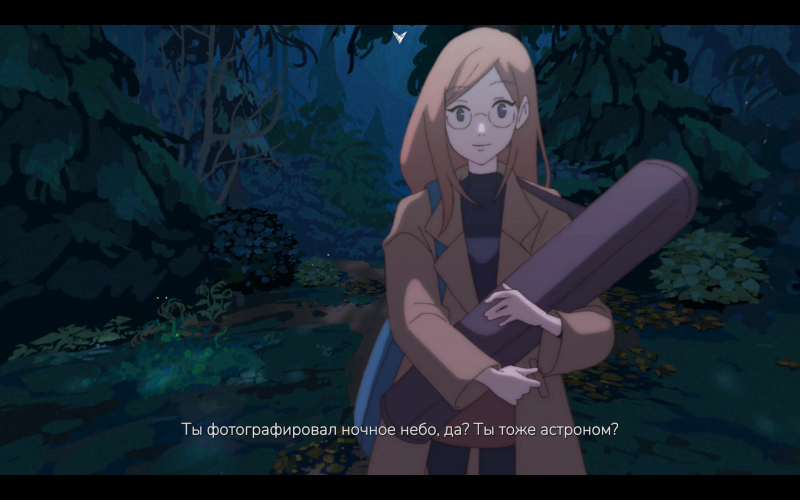Day wakes up in his room, bathed in sunshine. On the wall is a map with all the places he will definitely visit. The cabinet doors are painted with maps of the starry sky. There is a globe on the nightstand. The safe contains a camera and a compass, the traveler’s faithful companions. On the bedside table is a letter from my mother with a photo from the trip. Isn’t it time to move towards her with a camera at the ready?
Most likely, you were hooked on the word “safe” in the paragraph above. Although, on the other hand, what’s unusual, since we’re talking about a video game, especially a puzzle. To keep the player’s brain occupied, the developers are forced to hide various items necessary to advance the plot in the most ingenious ways, including violating the logic of things. But in The Star Named EOS, such moments are explained very well through a series of images.

Our goal as we proceed is to repeat the photographs using available means.
Day, unlocking various locks and finding codes for safes, rummages through his memory. He is actually looking for clues to his memories, his personality, which at the beginning of The Star Named EOS seems to be shrouded in fog (one might say, even the fog of war, yes). And he seeks contact with his mother, following in her footsteps through repeating her photographs sent to his son. Recently or some time ago? Will Day meet her, or will she meet something else? It is these questions that the game asks at first, thereby creating a thread on which a very emotional plot will be further strung like beads: about the search for beauty in any litter, about the feeling of one’s place in the vast Universe, about how dreams change over time.
Moreover, these themes are revealed using very minimalistic means. You can’t even walk into The Star Named EOS! Essentially, we are dealing with a very advanced version of the game of the hidden objects subgenre. I think Silver Lining Studio’s creation would look great on mobile devices. Not because it is primitive or shallow (stereotypes about mobile games are persistent, but not entirely true), but precisely because of the nature of the gameplay. We look for active objects on the screen, interact with them, solve puzzles and use various objects. Everything is resolved within one screen; there is no need to move anywhere or rummage through your inventory. The riddles are sometimes difficult, but due to the reduction of input, they can be solved – you just need to carefully study the environment, paying attention to symbols, numbers, and so on. In this case, fortunately, without pixel hunting, all active objects are clearly highlighted and obvious.

Including you will have to make unexpected collages
Having talked about the basic gameplay, let’s move on to the specifics of The Star Named EOS. For its creators, the Taiwanese Silver Lining Studio, this is the second game – and both are dedicated to art, only if Behind the Frame is about drawing with the corresponding mechanics, then The Star Named EOS is about photography. But the essence is approximately the same – the search and expression of oneself through a special view of the world around us. And Silver Lining Studio’s new game even has nice references to the previous one, although the main theme here is completely different. Just like the core game mechanics.
There are indeed a lot of games dedicated to photography: starting with the long-standing Pokemon Snap, continuing with more or less recent Umurangi Generation, Penko Park, TOEM, Viewfinder, Season: A Letter to the Future, and so on. In fact, photography is a very convenient tool for “non-violent” exploration of virtual space. And most importantly – studying the contemplative. This tool forces you to focus on the surrounding space, look closely at it, and not run or click through in search of solutions to problems.

There are also “tags” that are mandatory for puzzle games, fortunately they are not complicated here
This is, among other things, a method to avoid “walking simulation” in games focused primarily on immersion in the atmosphere and plot, and to create an emotional connection through at least conditional interactivity. Yes, in fact, you are simply looking at the same gaming environment, but through the same virtual lens – however, the effect of presence and the fact that you are doing something inside this virtual space, and not just moving around it detachedly, is already created. And a certain connection arises with the subject of the game action.

The Hydrometeorological Center warns that increased mischief is expected!
Further, everything depends on the super-tasks set by the developer and the methods of using these mechanics. Somewhere, like in Viewfinder, spatial puzzles are built on this, somewhere it’s an excursion game, like Umurangi Generation or Penko Park, and somewhere it’s one of the mechanics, like in Season or The Star Named EOS. Where the latter, in addition to creating additional interactivity, focuses on the property of photography to preserve memory. Because ultimately, The Star Named EOS turns out to be a game about memory, its distortions and a person’s ability to regain it with the help of photographs. And also about the ability to conduct a dialogue through photographs. And even about being able to continue another with the help of art.
***
The Star Named EOS is a very short and simple game with a set of quite interesting puzzles. But its short duration, coupled with the very narrowly defined framework of the world, is precisely its advantage, because the creators simply do not have time to lose focus. Yes, this is actually a macro photograph taken with an open aperture – there are literally several objects in the sharpness zone, the rest blurs into colorful bokeh. But a closer look at the small is sometimes more important than trying to capture more of everything at once with the help of a panorama. Just like a short story, it can evoke more powerful emotions than the multi-figure composition of a thick novel. I can’t say that Silver Lining Studio produced a very deep work, but you can’t deny its emotionality and ability to focus on what’s important.
Advantages:
- A touching and poetic story told with simple expressive means;
- Interesting and not too dreary puzzles;
- The cute visual style is clearly influenced by Studio Ghibli anime.
Disadvantages:
- Extreme asceticism of game mechanics;
- Short duration – although it suits the game better.
Graphic arts
The Star Named EOS isn’t exactly technologically advanced, but it’s definitely charming in its cartoonish charm. However, I would like to find fault with the minimal number of stage-screens – this is also an artistic device, but the poverty of the studio is directly felt.
Sound
Romantic and dreamy melodies match what is happening, a touching song on the credits – everything is as befits such a project with modest visual means, where a lot depends on the music. There is even voice acting for not too many text inserts – everything is fine with that too.
Single player game
A puzzle on static scenes with the possibility (and sometimes the need – these are also puzzle elements) to take photographs in the process. But these mechanics tell an emotional story – and the connection between the simple gameplay and the plot is built very well.
Collective game
Not foreseen.
Approximate travel time
2-3 hours.
General impression
The Star Named EOS does not set itself enormous tasks – it is a modest, cozy and very minimalist puzzle game. But even when playing their toy piano, the developers successfully hit the right emotional keys. Fans of small touching stories for the evening will definitely like it.
Rating: 8.0 / 10
More about grading system
Video: